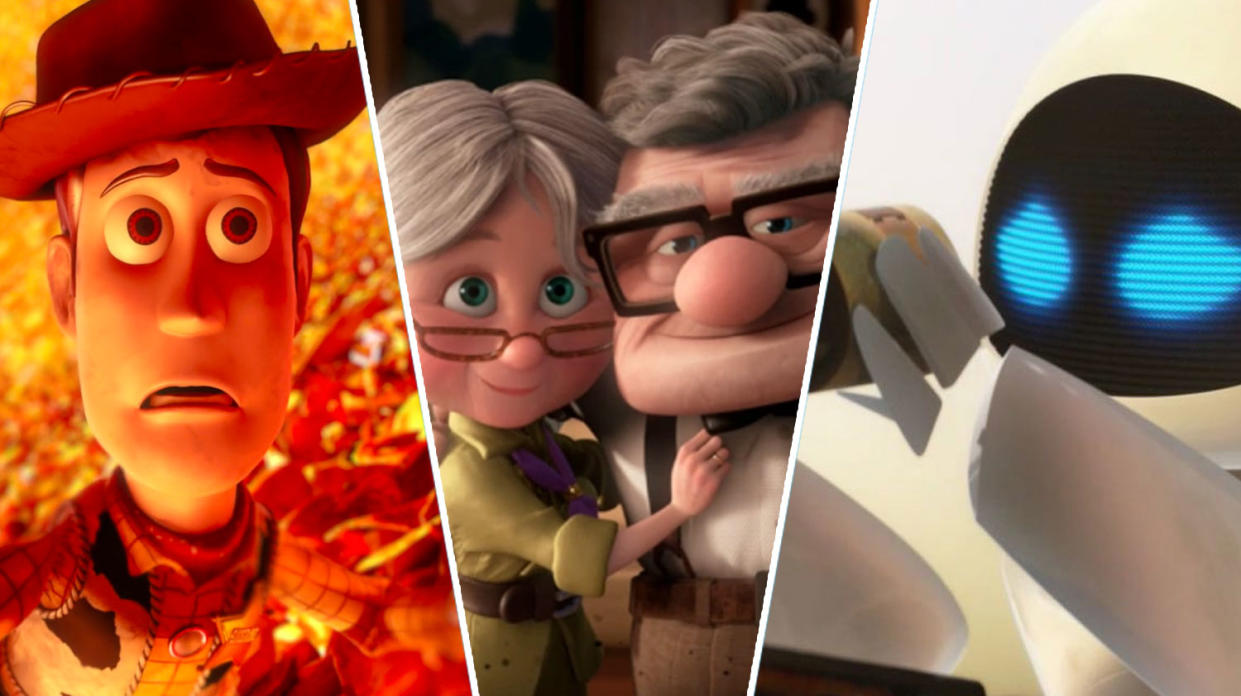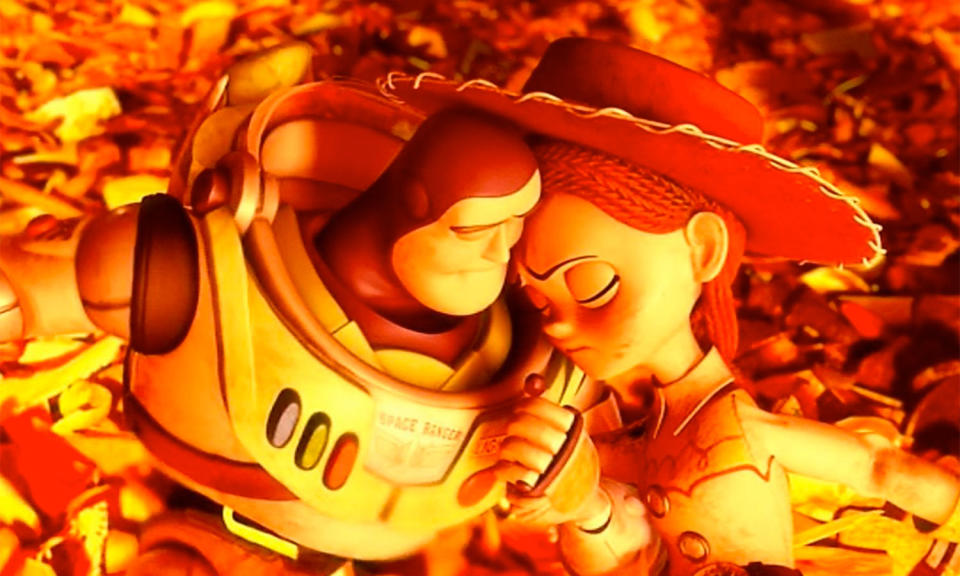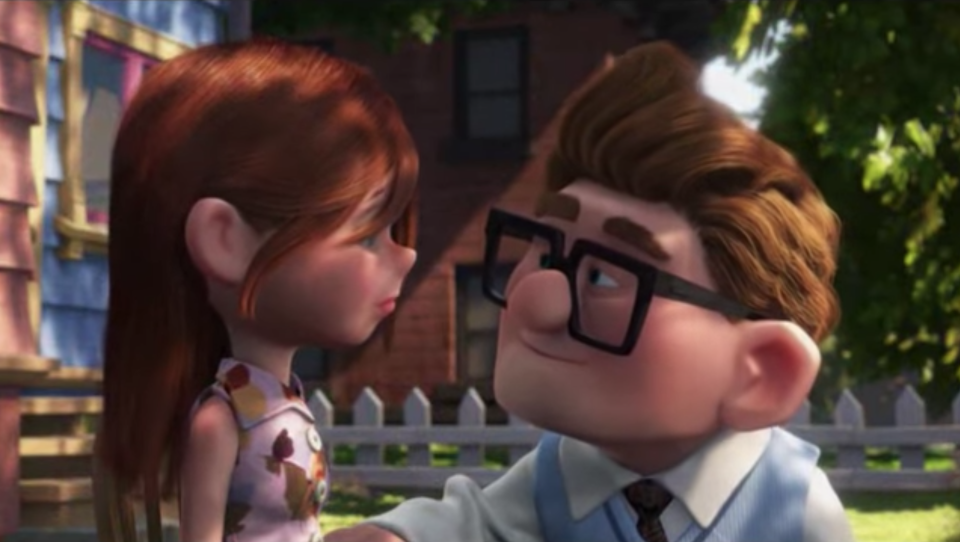10 Pixar scenes guaranteed to make you cry

The filmmakers at Pixar are master manipulators: few studios can reduce you to a sobbing wreck like they can. The emotional architects have built an empire on such solid character work, creating movies that can delight younger viewers while simultaneously having adults in tears. But what is Pixar’s most blub-inducing moment to date?
Be warned: there are SPOILERS AHEAD, and you will find yourself needing tissues…
Spot and Arlo bond over loss in The Good Dinosaur

As with a lot of Disney and Pixar film, 2015’s The Good Dinosaur kicks off with some good old-fashioned parental loss. Nervy apatosaur Arlo watches his father Henry die in a flash flood that sweeps him away far from home, but its not until he meets feral human Spot that he truly begins to grapple with his grief. Using stick figures in sand to represent their families, Arlo shares his loss with Spot, who then reveals that he is in fact an orphan himself. The moment Spot begins to comfort the dinosaur in the face of his own unimaginable grief will always trigger the waterworks.
Marlin leaves Dory in Finding Nemo

The movie’s opening scene, in which Nemo’s mother is killed protecting her babies, is a gut-punch indeed, but we haven’t really got to know any of the character by this point; that’s why this scene, involving Nemo’s father Marlin and his forgetful pal Dory, hits home. Torn apart by grief after he thinks he learns of Nemo’s death, Marlin (temporarily) abandons Dory, who – excuse the pun – flounders in his absence. Dory’s tearful admission that she remembers better when he’s around cuts through the comedic character’s core and Ellen DeGeneres sells the moment beautifully.
Anton Ego’s childhood flashback in Ratatouille

As Disney’s relentless stream of straight-to-video sequels seem keen to explore, villains usually have a back story – a reason they came to be the way they are. Ratatouille’s panto baddie Anton Ego is no exception, but few characters have their ethos summed up quite so eloquently or as succinctly. The food critic, intent on closing down Gusteau’s restaurant, takes one mouthful of rat chef Remy’s titular dish and in an instant is transported back to his childhood, where his mother serves him the very same feast. No need for an Anton Ego prequel, then.
The final shot of Monsters, Inc.

Here’s a moment that’s not technically ‘sad’ but it’ll have you weeping every time. Scarer Sulley spends the entire movie overcoming his fear of children and learning to love little lost Boo until he becomes her surrogate father – making the decision to send her back home where she can’t be harmed all the more heart-rending. The movie’s last shot, however, undoes all that emotional heavy lifting, when we see a lip-wobblingly effective final shot of Sulley from Boo’s point of view as he emerges, smiling, from her bedroom door to be greeted with a cry of “Kitty!” You’d have to be a monster not to melt.
The death of Bing Bong during Inside Out

Surprisingly for a movie which anthropomorphises emotions themselves, it’s not Sadness who provides Inside Out’s saddest moment but Bing Bong, the candy floss pink imaginary friend that resides forgotten inside 11-year-old Riley’s head. A silly fragment of her childhood that had no place in Riley’s new grown-up worldview, Bing Bong was destined to be sidelined while Joy and Sadness wrestle for control of Riley’s emotions; what we didn’t expect was quite how hard it would be to say goodbye to him. The loss of childhood innocence is rarely handled with quite so much care.
WALL-E forgets Eve

If you want proof of Pixar’s ability to bring characters to life, WALL-E is it: this love story between two mute robots is among the most touching work the studio has ever produced. For the whole movie, we see lovelorn trash-compactor WALL-E dote on sleek futurebot Eve (even when she’s unconscious), but when the robot has to be rebooted and returns to his default autonomous state, forgetting his feelings for Eve, you realise just how much love has drained from those big emotive eyes of his. Thank goodness for the randomly-accessed memory, generated from Eve’s tender kiss.
The furnace scene in Toy Story 3

Oh god. You know the scene. Pixar rarely push audiences this far towards peril: Woody and the gang are left abandoned on a trash heap after being betrayed by Lotso Huggin’ Bear, inching closer every second towards a fiery furnace fate. ‘They wouldn’t!’ you think. Closer still. ‘They can’t!’ you sniff. Closer still. They don’t, of course, but it doesn’t matter – because the real killer moment in the scene is Woody taking Buzz by the hand and the gang following suit, grimly accepting their fate. If they have to go, they’re going to go together: that’s the dark side of ‘You’ve Got A Friend In Me’.
Jessie’s song in Toy Story 2
Most of the entries on this list deal with death, or at least the concept of death, but Toy Story 2 deals with loss in a very literal way. We’re introduced to yodelling cowgirl Jessie, who has a tragic back story; as Sarah McLachlan sings When She Loved Me, we hear how Jessie’s previous owner accidentally abandoned her in the wilderness to fend for herself, making her the hardened, independent spirit she is. It’s the perfect conflation between music and story and sums up the essence of Pixar’s genius: their ability to give not just life but genuine soul to their characters.
Mama Coco remembers her father

The central premise of Pixar’s Oscar-winning Coco is that your spirit lives on in the Land of Dead only if someone in the living world remembers you. So after young Miguel discovers the vagabond guitarist Héctor is really his deceased great-great-grandfather, and the father of his beloved Mama Coco, it’s a race against time for the boy to remind Coco of her bond with Hector, and save him from oblivion. At risk of being disowned by his music-hating family, Miguel begins to sing ‘Remember Me’ to his ailing great-grandmother, and for a moment it seems like a lost cause. When Coco stirs from her daze and begins singing along to the song her father wrote for her as a child, it’s a stirring moment guaranteed to bring tears to your eyes.
The opening sequence of Up

How many of you were grateful of those 3D glasses to mask your blubbing eyes? Pete Docter’s showstopping opening montage to Up is a masterclass in economic and emotive storytelling: in just five minutes, we see Carl and Ellie meet, fall in love, get married and then subsequently suffer through all of life’s hardships along the way – until suddenly it’s just Carl. The scene contains a series of emotional sucker punches that will surely be lost on younger audiences; Carl and Ellie’s dreams are forever put on hold while they deal with reality, until it’s just too late. Tragic? Yes. But ultimately – and later literally – uplifting? You bet: Up urges us all to live out our lives before the clock runs out.
Pixar’s latest Incredibles 2 hits cinemas 13 July.
Read more
Disney scenes that will give you nightmares
Classic movies that will NEVER be remade
The best unofficial movie trilogies

 Yahoo Movies
Yahoo Movies 
